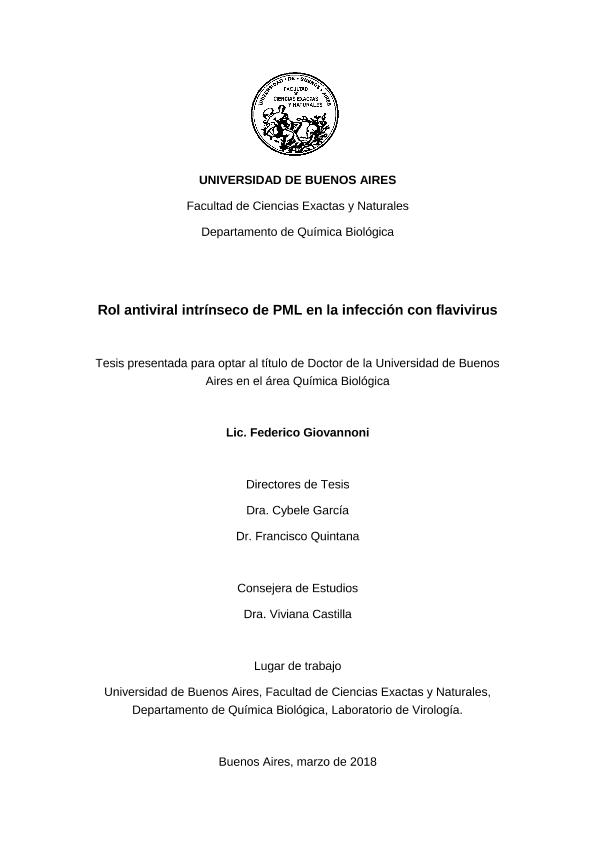Tesis doctoral
La inmunidad intrínseca es mediada por proteínas expresadas constitutivamente por la célula y que pueden bloquear directamente la replicación viral. Mientras que la activación de la respuesta inmune innata a través de la vía del interferón requiere de varias horas, los efectores de la inmunidad intrínseca se encuentran disponibles incluso antes de la primera interacción entre el patógeno y la célula. De este modo, la inmunidad intrínseca es la primera respuesta frente a las infecciones virales. El estudio de la inmunidad innata e intrínseca no solo aporta conocimientos básicos, sino también, la identificación de potenciales candidatos para el desarrollo de agentes antivirales. Por ello, el presente trabajo de tesis tiene por objetivo general la caracterización de factores mediadores de la respuesta inmune innata e intrínseca. La proteína de la leucemia promielocítica (PML) es una de las moléculas involucradas en la inmunidad intrínseca frente a múltiples virus. PML actúa como centro organizador de estructuras nucleares conocidas como Nuclear Bodies (PML-NBs). Una gran cantidad de virus, tanto con genoma de ARN como de ADN, codifican la información para proteínas que interaccionan y desestabilizan a los PML-NBs con el fin de evadir la respuesta antiviral. Como primer objetivo de este trabajo de tesis, proponemos estudiar el rol antiviral de PML frente a la infección con el flavivirus dengue (DENV) en cultivos celulares. A través de estudios de silenciamiento y sobreexpresión de PML, demostramos que PML ejerce un efecto antiviral frente a los cuatro serotipos de DENV. Más aun, por medio de técnicas clásicas de biología molecular, microscopía confocal y otras técnicas de microscopia de fluorescencia avanzada, demostramos que la proteína NS5 de DENV interactúa con PML con el propósito de neutralizar su efecto antiviral y favorecer la replicación de DENV. En una segunda instancia, con el objetivo de identificar nuevas moléculas o pathways relevantes en infecciones virales, realizamos análisis de microarrays y RNA-Seq de células infectadas con DENV y Zika (ZIKV). Dentro de la lista de pathways obtenidas, decidimos profundizar el estudio sobre la vía del receptor de hidrocarburos de arilo (AhR), debido a su potencial relación con la respuesta innata. En estudios in vitro realizados con ZIKV, demostramos la relevancia de AhR frente a esta infección. La activación e inhibición farmacológica de AhR causa un incremento o disminución de la replicación viral, respectivamente. Estos resultados fueron obtenidos tanto en líneas celulares, como en cultivos primarios de astrocitos y neuroprogenitores. En conclusión, en este trabajo de tesis describimos por primera vez la importancia de PML en la respuesta antiviral intrínseca contra DENV. Además, obtuvimos un perfil de expresión de células infectadas con DENV y ZIKV e identificamos nuevos pathways relevantes en la infección viral. Finalmente, demostramos por primera vez que AhR es un modulador de la replicación de ZIKV. Intrinsic immunity is mediated by constitutively-expressed cellular proteins that can block virus replication immediately. While the triggering of the innate immune response through interferon signaling requires at least a few hours, intrinsic immunity effectors are present even before the first host-pathogen interaction. Thus, intrinsic immunity is the first cellular immune response against a virus. Understanding both innate and intrinsic immunity effectors is of great importance to identify potential targets for the development of broad-range antiviral drugs. Therefore, the general objective of this work is to characterize effectors that mediate intrinsic and innate immune responses. Promyelocytic-leukemia protein (PML) is one of the many known proteins to be involved in intrinsic immunity against viruses. PML is the key organizer of subnuclear structures called Nuclear Bodies (PML-NBs). Different DNA as well as RNA viruses encode proteins that interact and disrupt PML-NBs to overcome PML-mediated antiviral response. The first objective of this work is to study the antiviral role of PML against the flavivirus dengue (DENV) in cell culture. Using PML-silencing and overexpression studies, we demonstrated that PML has antiviral activity against the four different DENV serotypes. Moreover, by using classic molecular biology techniques, as well as confocal microscopy and advanced fluorescence microscopy techniques, we showed that DENV NS5 protein interacts and disrupts PML-NBs to neutralize PML antiviral effect and, therefore, support DENV replication. In a second stage, we aimed at identifying new molecules or pathways that might be relevant for supporting virus infection. For this, we performed microarray and RNA-Seq analysis on DENV and Zika virus (ZIKV) infected cells. From the resulting list of hits, we decided to evaluate the role on virus replication of the Aryl Hydrocarbon Receptor (AhR) pathway due to its close association with innate immunity. In experiments performed with ZIKV virus, we showed for the first time the importance of AhR in modulating virus replication. Upon inhibition or activation of the AhR pathway, a decrease or increase in virus replication was observed, respectively. These results were obtained using cell lines, as well as astrocytes and human neural progenitors. In conclusion, this work provides the first evidence to support the role of PML as a restriction factor against DENV. Moreover, using microarrays and RNA-Seq we obtained a list of potentially relevant pathways for virus replication and we validated our results describing the importance of AhR as a modulator of ZIKV replication.
Rol antiviral intrínseco de PML en la infección con flavivirus
Título:
Role of PML in the intrinsic immunity against flaviviruses
Fecha de publicación:
01/01/2018
Idioma:
Español
Clasificación temática:
Resumen
Palabras clave:
Inmunidad
,
Flavivirus
,
Dengue
,
Zika
Archivos asociados
Licencia
Identificadores
Colecciones
Tesis(IQUIBICEN)
Tesis de INSTITUTO DE QUIMICA BIOLOGICA DE LA FACULTAD DE CS. EXACTAS Y NATURALES
Tesis de INSTITUTO DE QUIMICA BIOLOGICA DE LA FACULTAD DE CS. EXACTAS Y NATURALES
Citación
Giovannoni, Federico; Garcia, Cybele; Quintana, Francisco; Castilla, Viviana; Rol antiviral intrínseco de PML en la infección con flavivirus; 1-1-2018
Compartir




